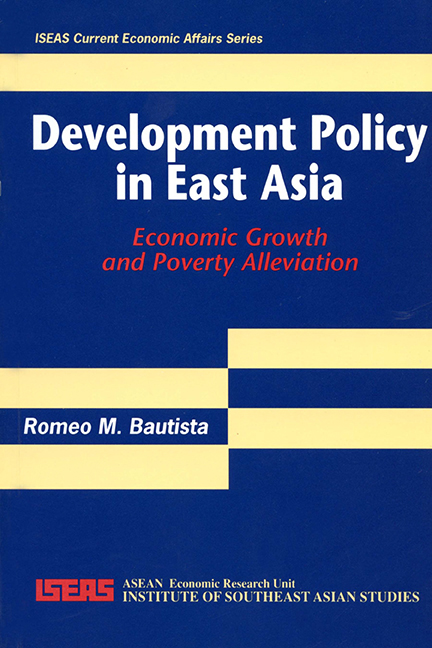Book contents
- Frontmatter
- Contents
- List of Tables
- 1 Introduction
- 2 Measures of Development Performance
- 3 Analytical Considerations
- 4 Economic Conditions in 1965
- 5 Role of Development Policies
- 6 Some General Equilibrium Estimates of Policy Effects
- 7 Redistributive Policies
- 8 Concluding Remarks
- Notes
- Bibliography
- The Author
8 - Concluding Remarks
Published online by Cambridge University Press: 21 October 2015
- Frontmatter
- Contents
- List of Tables
- 1 Introduction
- 2 Measures of Development Performance
- 3 Analytical Considerations
- 4 Economic Conditions in 1965
- 5 Role of Development Policies
- 6 Some General Equilibrium Estimates of Policy Effects
- 7 Redistributive Policies
- 8 Concluding Remarks
- Notes
- Bibliography
- The Author
Summary
The post-1965 record of East Asian development performance demonstrates the considerable scope for complementarity between poverty alleviation and economic growth in the development process. We can also conclude that government policies have been a major determinant of the development path for the East Asian LDCs, including the outcomes in income growth and distribution. Behind the success stories is a development strategy and policy environment conducive to output mixes, technology choices, and patterns of trade that roughly conform to the country's initial factor endowments and evolving comparative advantage. On the other hand, development performance is observed to be inferior in both growth and equity where government policies heavily discriminate and distort the production structure (favouring industry over agriculture, import-competing over export-oriented sectors, non-tradables over tradables), market orientation (domestic market over foreign markets), size structure (large over small firms and farms), and relative factor use (capital- intensive over labour-intensive technologies and production techniques).
Contrary to popular impression, export-oriented or “outward-looking” policies do not deliberately promote exports beyond the level that would result from unrestricted trade. The objective of such policies is to neutralize the existing bias against exporting, due to trade restrictions (import quotas and tariffs) and associated exchange rate overvaluation, through import liberalization and/or various forms of export incentives. This is not to suggest that export- led development strategies adopted by the Asian NICs did not go “beyond free trade”; nor does it mean that a positive bias in favour of exports is not defensible on “externality” grounds.
The Philippines, Thailand, and Indonesia did not switch to export-oriented policies, after the easy import substitution in final consumer goods was exhausted, as quickly as Taiwan, South Korea, and Singapore. As indicated above, exports of labour-intensive manufactured products in the latter countries expanded sharply from the mid-1960s to the early 1970s, substantially contributing to labour employment and economic growth, which was favoured by the continuous rapid expansion of the OECD economies and substantial decline in industrial protectionism.
- Type
- Chapter
- Information
- Development Policy in East AsiaEconomic Growth and Poverty Alleviation, pp. 51 - 53Publisher: ISEAS–Yusof Ishak InstitutePrint publication year: 1992



